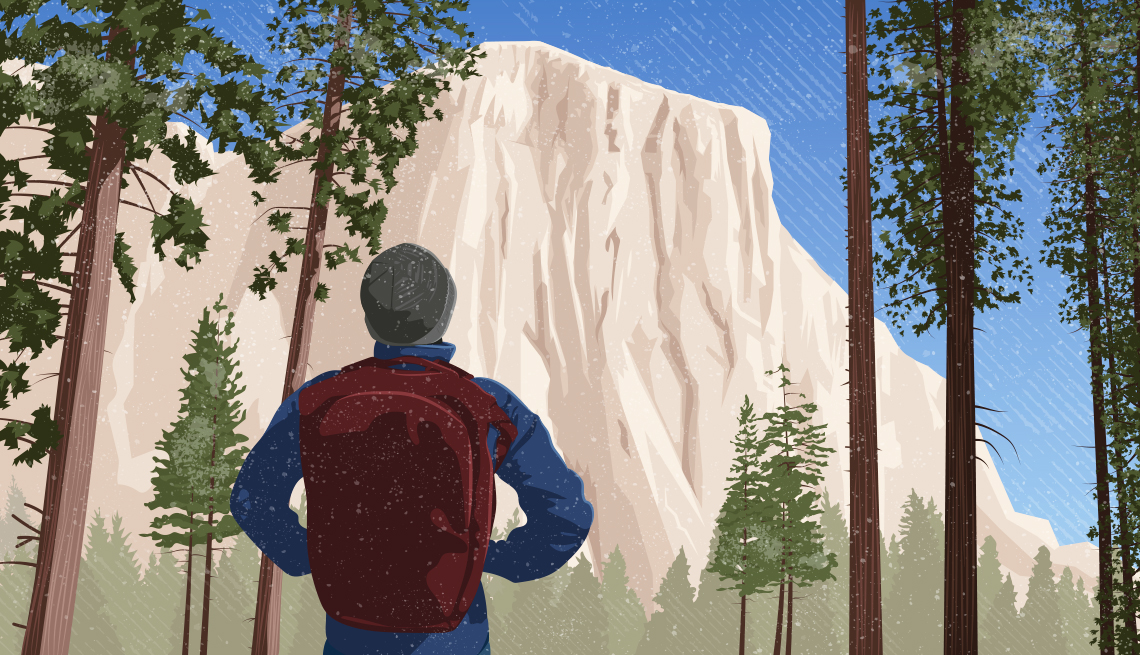
Life's a journey: escaping covid fatigue in yosemite | members only access
- Select a language for the TTS:
- UK English Female
- UK English Male
- US English Female
- US English Male
- Australian Female
- Australian Male
- Language selected: (auto detect) - EN
Play all audios:

NOT THE SAME PARK Peter Fish says although travelers often spend most of their time in the valley, you haven’t really seen Yosemite National Park until you’ve been to its mountains. Courtesy
Peter Fish I followed Wawona Road down into the valley. If you’ve been there, you know the view that welcomed me. The meadows, golden in fall, and the cottonwoods and oaks. The Merced
River, a docile trickle this time of year, and the glacier-carved valley walls. I recalled memories of a lifetime of Yosemite visits. The campground where my parents and I camped when I was
8, where a bear swiped the half a hamburger we left on our grill. The stretch of the Merced where we inner-tubed. The gentle trail where I took our 5-year-old son on his first Yosemite hike,
and the steep trail down from Glacier Point, our most recent trek together. But the park was different on this sunny midweek autumn day; when it should have been mildly busy, Yosemite was
silent and empty. I had thought it would be insulated from the virus-rattled world outside. It wasn’t. Although the park had reopened after being shut down for three months earlier in the
year, most campgrounds remained closed. The visitor center was shuttered, replaced by two information tents in a parking lot. You saw COVID cautions everywhere: posted reminders about masks,
social distancing, sanitizer. Still, it was a fine fall day that I didn’t want to waste, so I headed toward one of my favorite spots, up the Mist Trail toward Nevada Fall. I kept my eyes
open for wildlife, having heard that, with fewer people in the valley, bears and bobcats were reclaiming their habitats. I then ambled across Cook’s Meadow, watching a herd of grazing deer.
I missed the people — kids gathering for Junior Ranger talks, foreign tourists exclaiming over Half Dome’s beauty in French or Japanese. I missed displaying my park knowledge when newcomers
asked directions. “That’s El Capitan over there. In Star Trek V: The Final Frontier, Captain Kirk climbed it,” I’d say. I’d made a reservation for a fancy dinner at the Ahwahnee, Yosemite’s
grandest hotel, now socially distanced and regimented. The sparse, masked crowd of diners kept our distance from one another, grabbing our prime rib and Caesar salads cafeteria-style, in
cardboard boxes. I had bought a newspaper at the valley grocery store and brought it to read, unwisely, given all the virus-related headlines. I ordered an expensive glass of wine, the type
you buy when you want to toast somebody, but there was only me. ANOTHER DAY, MORE EXPLORING The next day I drove to Yosemite’s south edge, to Mariposa Grove, the park’s largest grove of
giant sequoias: 500 in all. The last time I had visited it had been mobbed by us tree-gazers shuffling past the sequoias like Disneyland day-trippers in an interminable line for Star Wars:
Rise of the Resistance. Now only a few of us were admiring the 209-foot-tall Grizzly Giant and the Faithful Couple (two sequoias grown together), trying to capture the arboreal majesty with
smartphone cameras. Walking beneath living things thousands of years old, I found myself thinking about the park’s history, both heroic and troubled. Established by Abraham Lincoln in 1864,
Yosemite was the first natural landscape in America set aside for its beauty. But its original inhabitants, the Miwok people, were essentially pushed off the land they called their own.
(Now, belatedly, the park service and other agencies are trying to partially right these wrongs; projects include a new roundhouse for Native American cultural and spiritual ceremonies.)
Over its 150 years, Yosemite has endured illegal logging, floods and wildfires, even war. In World War II, the Ahwahnee became a naval hospital, treating hundreds of wounded vets. The trees
had witnessed all of these crises and more. What was a pandemic to them? But we were not trees.
